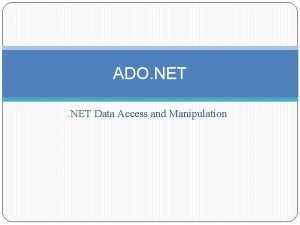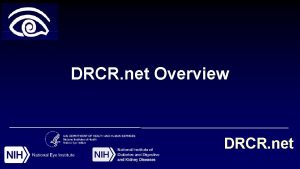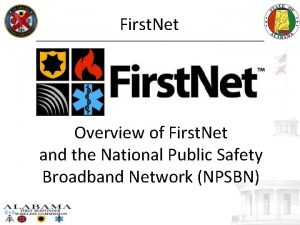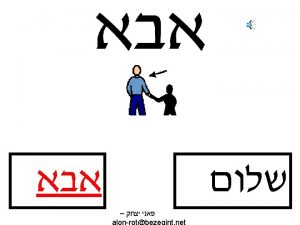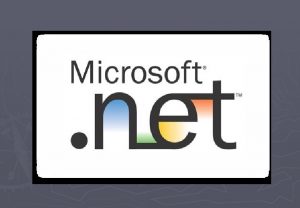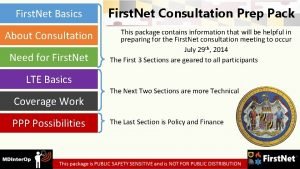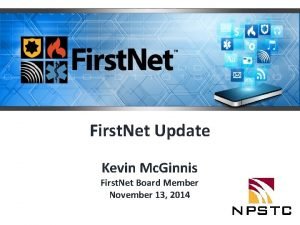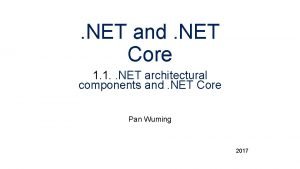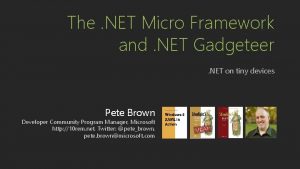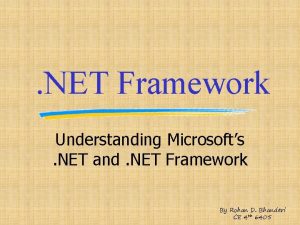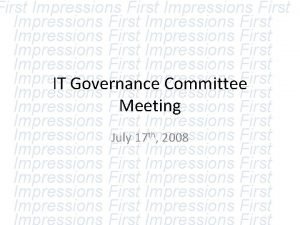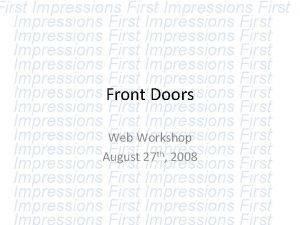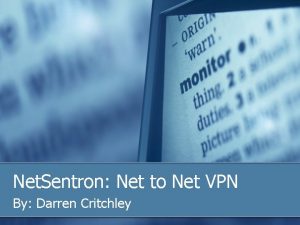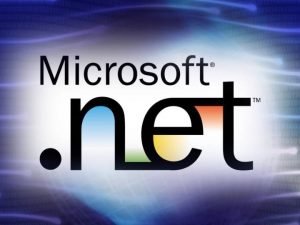First Net Overview of First Net and the

























- Slides: 25

First. Net Overview of First. Net and the National Public Safety Broadband Network (NPSBN)



First. Network • Long‐Term Evolution (LTE) Cellular Wireless Network specifically for First Responders. • Initially, the First. Net network will be used for data only, not voice.

First. Network Spectrum • First. Net is the license holder for Public Safety’s Broadband allocation – Band Class (BC) 14 • First. Net is an additional Wireless Carrier. AT&T Dish AT&T Verizon PS Broadband LMR AT&T BC 14 UL UPLINK DOWNLINK DL DOWNLINK 6 MHz 12 MHz 11 MHz 10 MHz 6 MHz BC 13 BC 14 LMR PS Narrowband BC 13 PS Broadband BC 29 Verizon BC 17 BC 12 PS Narrowband BC 17 BC 12 UPLINK 11 MHz 10 MHz 6 MHz 1 MHz Guard Bands

First. Network Benefits Dedicated to Public Safety Qo. S, Priority & Preemption (QPP) Public Safety Apps / Services Situational Awareness Local Control Public Safety Grade

First. Network Quality Priority & Preemption

First. Network Quality Priority & Preemption

First. Network Quality Priority & Preemption

First. Network Applications Purpose: First. Net application and developer certification is designed to maintain the integrity, reliability, privacy and security of the network, devices, and data. Enable unique public safety Applications • Resilient, reliable, easy to use, and remotely manageable apps with a public safety focus Development driven by public safety needs • Expand support a vibrant public safety app developer community Lifecycle Management • An ecosystem that supports developers and app management from learning, through development, test, deployment, support, monetization, and end‐of‐life • MC Push to Talk • CAD • Mapping/Weather/Traffic • Incident Management • Video sharing • Administrative Tools • Database Access • User Authentication • Compliance Monitoring

First. Network Devices § Device certification process to ensure the quality, accessibility and safety of the network and ensure interoperability § New device and accessory designs, driven by market research and public safety feedback § Incorporate new innovations and categories – – Sensors Aerials Virtual Assistants Public safety focused accessories

First. Net Roadmap as of 4/2016 From: Middle Class Tax Relief Act of 2012 To: Nationwide Public Safety Broadband Network These milestone are target dates based on the best current information available to First. Net. April 12, 2016

From: Strategic Program Roadmap Release Initial State & Territory Consultations To: RFP Release Draft RFP Documents Gather Early Builder Key Lessons Receive PSAC Findings RFP Released 2015{}2016 Release Strategic Program Roadmap • Initial Consultation meetings in 55 states/territories (Alabama 4/2015) • Data Collection in state/territories • Industry Days with 400+ attendees • Tribal outreach and consultation • NEPA/HIPA consultation Phases I & II 2014 -15

To: Complete Draft State Plans From: RFP Release Focused Consultation with Expanded Outreach Architect State Plans Process & Elements Award RFP for Network Partnership 2016{}2017 March • • • Consultation Task Teams Governance Body Mtgs Executive Consultations In-Person SPOC meetings PSAC Findings Complete Draft State Plans May Culmination of: • Extensive Q&A Process • Pre-proposal Conference • Capabilities Statements • Proposal Submissions • Best Value Determination Phase III * “These milestone are exclusively controlled by the respective agencies and we have provided target dates based on the best current information available to First. Net. However, the final timing and outcomes from the relevant proceedings may materially change based on the decisions of the relevant agency. "

To: Initial Markets Launch From: Deliver Draft State Plans Deliver & Discuss Draft State Plans Finalize State Plans Synchronous Delivery of 56 State Plans National Deployment Initial Markets Release Governors’ Decisions 2017{}2018 May Phase IV Opt-out State plan due to FCC from State National Deployment Initial Markets Launch August Initial markets installed by national partner and ready for “Go Live” testing and activation of PSE devices on the NPSBN

Responsibilities for Network Components Responsibility üFirst. Net CORE Backhaul / Transport q. First. Net q. State RAN DEPLOYMENT DEVICES / SERVICE Service Plan q. Agency Choice

State Plan Process Under the Act, the Governor has 90 days to choose whether to 1. Participate in the First. Net proposed radio access network (RAN) deployment or 2. Assume responsibility to conduct its own state RAN deployment

State Participates in First. Net Proposed RAN • Governor chooses to accept the deployment of the RAN as proposed by First. Net • First. Net is responsible for RAN deployment, including the building, operation, and maintenance of the State RAN • The State’s public safety entities will be responsible for paying user fees for the First. Net service, if they adopt the service First. Net Core First. Net RAN Deployment

State Conducts RAN Deployment The state must notify First. Net, NTIA, and FCC of its decision to deploy a RAN and then: Complete RFPs within 180 days • For statewide RAN construction, maintenance, and operation Submit alternative State plan for RAN deployment to FCC • Must meet minimal interoperability requirements FCC reviews alternative State plan • Disapproved – Network deployment follows First. Net proposed plan • Approved– State may apply to NTIA for a grant for RAN construction, but must apply to lease spectrum capacity If approved by FCC, apply to NTIA to lease spectrum capacity from First. Net • Must demonstrate “cost‐effectiveness” of state plan • Must show comparable completion timelines, security, coverage, and quality of service to that of the nationwide • Negotiate spectrum lease with First. Net public safety broadband network (NPSBN) • Enter into lease with First. Net Pay fees to use First. Net core First. Net Core State RAN Deployment

State Built RAN vs. Reinvestment of Funds Protect Deployment in Rural States While Preserving the Right of All States to Assume Responsibility for the RAN The Act preserves the right of States to construct and operate their own RAN, but not in a way that also allows them to capture funding, beyond the reasonable costs of such a RAN

First. Net Funding

First. Net Revenue Challenge Cost to Serve vs. Density of Population Revenue Exceeds Costs $0 Costs Exceed Revenue States Contributing More Than Their Costs States Costing More Than Their Revenues

First. Net (LTE) and LMR • When the First. Net network launches, it will provide mission‐critical, high‐speed data services to supplement the voice capabilities of today’s Land Mobile Radio (LMR) networks. • Today’s LMR networks support push‐to‐talk, direct mode, and emergency call functionality. Public safety users typically communicate one‐to‐many instead of one‐to‐one. • If the network fails, they also must be able to communicate with other responders in close proximity, so direct mode is critical. There also performance requirements for mission‐critical voice that address call set‐up speed, quality, and reliability. • These attributes need to be defined through the standards‐setting process. First. Net can’t predict the arrival of mission‐critical voice in part because the standards are still under development.

First. Net (LTE) and LMR Graphic Distributed courtesy of DHS OEC

Thank You for your time and service. Please contact me with any questions. Curtis Nail Alabama Law Enforcement Agency curtis. nail@alea. Alabama. gov
 Ado.net overview
Ado.net overview Hình ảnh bộ gõ cơ thể búng tay
Hình ảnh bộ gõ cơ thể búng tay Bổ thể
Bổ thể Tỉ lệ cơ thể trẻ em
Tỉ lệ cơ thể trẻ em Chó sói
Chó sói Tư thế worms-breton
Tư thế worms-breton Hát lên người ơi
Hát lên người ơi Môn thể thao bắt đầu bằng từ đua
Môn thể thao bắt đầu bằng từ đua Thế nào là hệ số cao nhất
Thế nào là hệ số cao nhất Các châu lục và đại dương trên thế giới
Các châu lục và đại dương trên thế giới Công thức tính thế năng
Công thức tính thế năng Trời xanh đây là của chúng ta thể thơ
Trời xanh đây là của chúng ta thể thơ Cách giải mật thư tọa độ
Cách giải mật thư tọa độ 101012 bằng
101012 bằng độ dài liên kết
độ dài liên kết Các châu lục và đại dương trên thế giới
Các châu lục và đại dương trên thế giới Thơ thất ngôn tứ tuyệt đường luật
Thơ thất ngôn tứ tuyệt đường luật Quá trình desamine hóa có thể tạo ra
Quá trình desamine hóa có thể tạo ra Một số thể thơ truyền thống
Một số thể thơ truyền thống Cái miệng bé xinh thế chỉ nói điều hay thôi
Cái miệng bé xinh thế chỉ nói điều hay thôi Vẽ hình chiếu vuông góc của vật thể sau
Vẽ hình chiếu vuông góc của vật thể sau Nguyên nhân của sự mỏi cơ sinh 8
Nguyên nhân của sự mỏi cơ sinh 8 đặc điểm cơ thể của người tối cổ
đặc điểm cơ thể của người tối cổ V cc
V cc Vẽ hình chiếu đứng bằng cạnh của vật thể
Vẽ hình chiếu đứng bằng cạnh của vật thể
